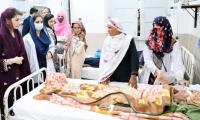Concern for the health of the poor is one of the critical issues in development. Poverty cannot be defined solely in terms of low or no income. Lack of access to health services, safe water, adequate nutrition, and education are also essential components of poverty. Poverty and health are closely linked. Poverty is one of the most influential factors in ill health, and ill health can lead to poverty.
Poverty drains family savings. In addition, poor people are more exposed to several risks (poor sanitation, unhealthy food, violence, drug abuse and natural disasters) and less prepared to cope with them.
More than 1.5 billion people in the world – most of them children – live in extreme poverty, and 80 percent of them live in developing countries. Poor people have little or no access to qualified health services and education, and do not participate in decisions critical to their day-to-day lives. UNICEF statistics show that 22,000 children die each day because of poverty.
People with low income are at greater risk of illness and disability. They are also less informed about the benefits of healthy lifestyles, and have less access to quality health care. It is estimated that one third of deaths worldwide – some 18 million people a year or 50,000 a day – are due to poverty-related causes.
Those who live in extreme poverty are five times more likely to die before age five, and two and a half time times more likely to die between 15 and 59 than those in higher income groups. The same dramatic differences can be found with respect to maternal mortality levels and the incidence of preventable diseases.
The impact of poverty on health is largely mediated by nutrition and is expressed throughout the lifespan. Those living in poverty and suffering from malnutrition have an increased propensity to a host of diseases, a lower learning capacity, and an increased exposure and vulnerability to environmental risks. It is estimated that 165 million children worldwide suffer from malnutrition.
However, nutrition and health are only moderately responsive to mere economic growth. Increased income alone cannot guarantee better nutrition and health because of the impact of other factors, notably education, environmental hygiene and access to health care services, which cannot necessarily be obtained with increased income in developing countries.
Education is one of the most powerful weapons to fight against poverty and its effects.
Experiences in several countries have shown the power of education to increase the nutritional levels and the health status of the poor. In that regard, girls’ education is one of the most effective investments countries can make toward development and better health. Those countries that have the greatest gender disparities in access to education, like Afghanistan, India, Ethiopia and Yemen are also among the poorest countries in the world.
In urban India, for example, it has been found that the mortality rate among the children of educated women is almost half than that of children of uneducated women. In the Philippines, primary education among mothers has reduced the risks of child mortality by half.
Several strategies can be used to improve the access of mothers and children to educational opportunities as a way of improving their health status and overcome poverty. At the national level, governments – particularly in developing countries – have to establish education as a priority, and provide necessary resources and support.
At the international level, lending institutions have to increase the number of debt-reduction plans for those countries willing to provide resources for basic education, particularly in rural areas and at the community level. Since an important goal is to reduce economic inequity to improve the health status of populations, education can provide substantial benefits to people of all ages.
Courtesy: Counterpunch.org
After November 30, it will be impossible for ordinary internet users to access all banned websites, including X
Muslims participated alongside their Hindu fellow villagers and other residents of area
For last eight years, HEC's budget has been virtually stagnant in absolute terms
Home to 14 million people, Lahore has always been celebrated as Pakistan’s historical, culinary, and cultural hub
Partnership between Pakistan and China in media and culture reflects shared commitment to strengthening bilateral...
This article focuses on single error committed by our respected judiciary which haunts me more than I would care to...







